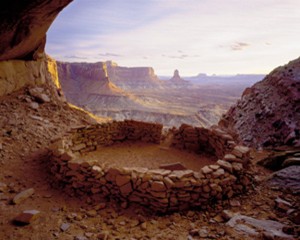Looking beyond one’s own small world and culture allows people to better understand others.
Val Brinkerhoff, associate professor of photography at BYU, traveled the world in the last six years trying to better understand other cultures. His travels have led him to various ancient places used for worship. Brinkerhoff’s interest in these places and the symbolism and cultural meanings behind them is the focus of his latest exhibition at the Springville Museum of Art, “Sacred Settings,” on display until April 30, 2013. The exhibition contains a selection of black and white and color photographs, from Brinkerhoff’s project, that were taken in over 40 countries.

As he traveled, he wasn’t looking for a particular church or landmark but for sites and spaces around the world that have been created for the sole purpose of worshiping a higher being.
Brinkerhoff decided to undertake this project when he had a desire to understand LDS temples as completely as possible. It became the focus of his life and research, and a passion.
“The answers lay in the past, in the ancient world,” Brinkerhoff said. “I read hundreds of books by skilled authors like Hugh Nibley and then had a desire to experience these sacred places around the world, not just read about them. Going there and seeing them led to understanding them more fully.”
Along with sacred places and symbolism, patterns and general architectural shapes behind them have been a focus of Brinkerhoff’s photography for many years; in the last six years alone he has traveled to some 45 countries to photograph these spiritual places.
“I received three mentoring grants and other funding that allowed me to take students and allowed me to study these places,” Brinkerhoff said. “In those travels I went to some incredible places where these sacred places are found. What you discover are these patterns that unite most all of these sacred settings.”
One of the places Brinkerhoff visited, Myanmar, led him to a deeper understanding of religion and worship in different cultures. Brinkerhoff spent ten days in Myanmar, previously known as Burma, photographing the over 3,000 sacred sites that were found every seven square miles. Every day, as Brinkerhoff described, was a new day of searching and discovery that has allowed him to find more meaning behind his quest in understanding the LDS temples.
“Once you recognize and see these places and patterns, you come home from these trips and see these special patterns repeatedly from a visual perspective, and the patterns lead to searching back in the books, and you find meaning,” Brinkerhoff said. “You research those patterns, and you search the scriptures along with answers to prayers, and you compare what you find in books, and answers are given. After you have all of that, then of course you want to share it with others.”
Charlotte Martell, a pre-acting major from Portland, Ore., likes the connection between religion and culture that Brinkerhoff’s photography displays.
“I think it’s really cool; he’s inspiring others to do their own search,” Martell said. “It shows both religion and history so it’s both a connection to religion and different cultures and it shows common threads there.”
Some of the places in his photographs are well-known for their religious significance — Stonehenge, Giza, Paris — while others include religious sites obscure to viewers.
However, Ashlee Whitaker, associate curator at the Springville Museum of Art, explained the common tie among the images.
“(Brinkerhoff) is opening up whole new layers of understanding in terms of what these sites mean and what sacred means,” Whitaker said. “Val is very focused on helping educate viewers about those things; he wants to share his vision with everyone. It’s a fabulous cultural and religious experience to spend time with his photographs and understanding them.”




